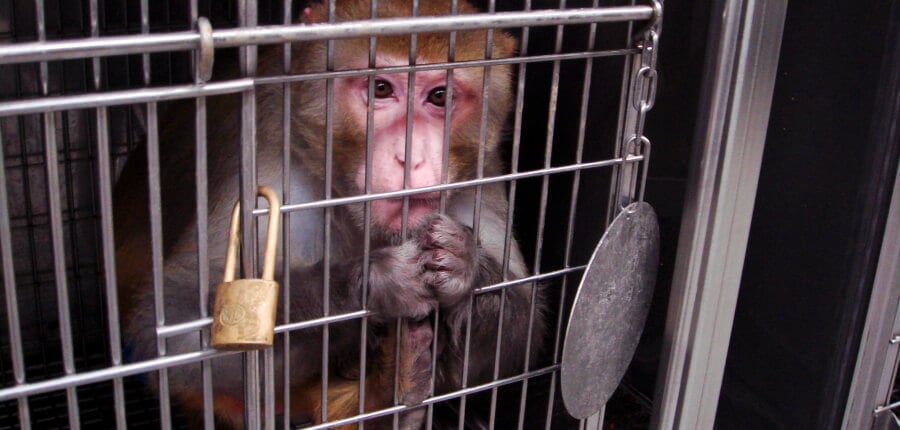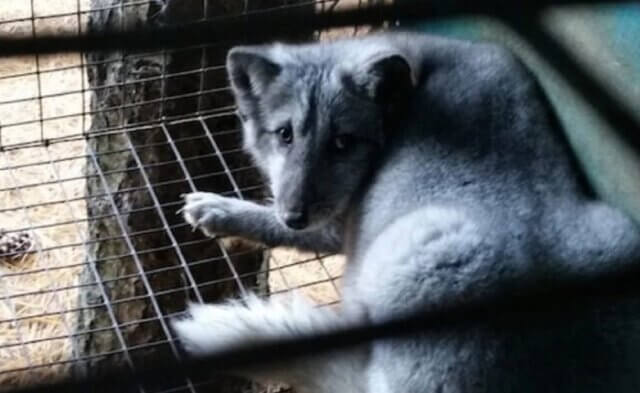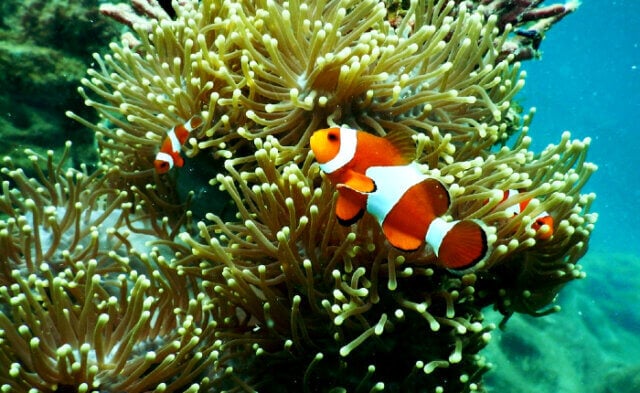Please enjoy this article from the latest issue of our magazine, PETA Global. To begin your subscription, become a PETA member today!
Here’s a first: Experimenters dropped the pretext that tormenting animals in the lab helps humans and instead (inadvertently) showed us their true colors. When US Sen. Rand Paul bluntly described the work of one experimenter as “spraying alcoholic rats with bobcat piss,” the “scientist” took to Twitter to ask his animal-exploiting peers to have some fun summarizing their own experiments:
“Forces monkeys to become tweakers and then kills them”
— David Jentsch (@jdavidjentsch), State University of New York–Binghamton
“Mice running on a homemade Peloton chasing imaginary cocaine”
—Manuel Esguerra (@MannyE16), University of Minnesota
“Screwing up rat brains with electricity and drugs”
—Neil Fournier (@FournierLab), Trent University
“Electrocuting mice and asking if drugs help them remember it”
— Rocco Gogliotti (@RoccoGogliotti), Loyola University
“Deafens, murders, and mutilates mice”
— Mike Kasten (@MadScientistPhD), University of North Carolina School of Medicine
“Traumatize teen rats and feed them comfort foods to death”
— Johnny Figueroa (@fig_neurolab), Loma Linda University
“Making birds better at soliciting sex”
— Caitlin Aamodt (@CaitlinAamodt), University of California–Los Angeles
A tweetstorm followed, and two things became clear: These experimenters know just how intolerably absurd and cruel their studies are, and they also foolishly believed that they were talking among themselves and that no one in the “real world” would catch wind of their confessions. Well, PETA did – and proceeded to spread the word.
The Price of Cruelty
More than 110 million mice, monkeys, dogs, cats, rabbits, and other animals are terrorized and killed in the US every year in pointless medical training exercises, biology lessons, curiosity-driven medical experiments, and chemical, drug, food, and cosmetics tests.
Who bankrolls most of them? Taxpayers. The US National Institutes of Health (NIH) rakes in $41.7 billion annually and then wastes nearly $19.6 billion a year on experiments using animals – even though 90% of basic research, most of which involves such experiments, fails to lead to treatments for humans.
Riding the Gravy Train
Meet Elisabeth Murray. She has worked in US government laboratories for three decades, spending nearly $50 million from NIH since 1998 to torture monkeys by carving up their skulls, injecting their brains with toxins, and scaring them with realistic-looking fake snakes and spiders. She also keeps monkeys thirsty to get them to cooperate, restrains them for hours, and blows puffs of air into their eyes. She claims that she’s shedding light on human mental illness, but that’s bunk – her experiments are designed to elicit fear and haven’t resulted in any new treatments or cures.
The seven federally funded US National Primate Research Centers also get hundreds of millions of taxpayer dollars every year to pry baby monkeys away from their mothers, electroshock monkeys’ penises, and breed additional monkeys to infect with Zika and other diseases. These behavioral and infectious disease experiments have led to the deaths of hundreds of thousands of primates in the last 60 years – but not a single vaccine to prevent disease.
Experimenters at Ohio’s Cleveland Clinic suction out parts of mice’s brains, breed them so that their pelvic organs prolapse, and, in an effort to mimic multiple sclerosis, inject them with a chemical that causes an inflammatory disease of the central nervous system, leaving them struggling to walk and dragging their hind legs. In 2019, the facility collected more than $100 million from NIH.
At Johns Hopkins University in Maryland, an experimenter pretends that he’s helping humans with attention-deficit disorder by cutting into owls’ skulls, sticking electrodes into their brains, forcing them to look at screens for hours, and bombarding them with noises and lights. He’s banked nearly $2 million from NIH and another $1 million from the university.
PETA Has a Plan That Will Work
PETA scientists have researched the current system’s failures and developed a road map for replacing animal experiments with superior, human-relevant methods. It’s called the Research Modernization Deal. The strategy includes the following:
- Eliminating the use of animals in areas in which they have proved to be poor human surrogates
- Reviewing additional research to determine where animal use can be phased out
- Redirecting funds into more promising, human-relevant research
- Introducing an ethical cost-benefit analysis system into US policies governing animal use
- Promoting harmonization of non-animal testing methods internationally
Take Action Now
Pfizer, Johnson & Johnson, and other pharmaceutical companies have banned the “forced swim test,” in which experimenters typically dose small animals with a test substance, drop them into waterfilled containers, and watch as they swim for their lives until they give up. Visit PETA.org/Despair to urge Eli Lilly to follow their example – now!
Through October 31, every donation made to PETA’s “Stop Animal Testing” Challenge will be matched dollar for dollar up to the $300,000 campaign goal—doubling your impact on PETA’s groundbreaking work to reduce suffering and get animals out of laboratory cages.





